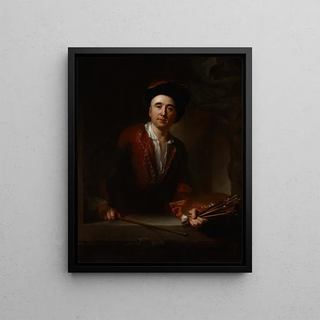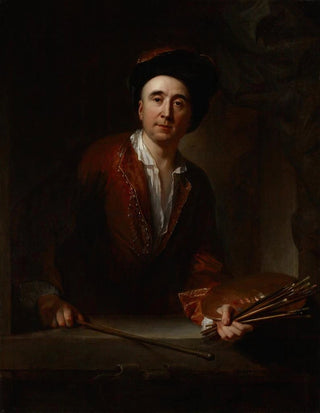Art print | Self-portrait - Jean-François de Troy Source: Reproduction | Autoportrait - Jean-François de Troy


View from behind

Frame (optional)
Jean-François de Troy's self-portrait is a captivating artwork that immediately draws the eye and inspires admiration. Created in the early 18th century, this iconic piece of the rococo movement embodies not only the undeniable talent of its creator but also a pivotal moment in the history of French art. Through this painting, viewers are invited to delve into the artist's intimate universe, where each brushstroke seems to whisper secrets of the past. The art print of this work allows for a rediscovery of the finesse and delicacy of the line, while offering a window into the creative spirit of a bygone era.
Style and uniqueness of the work
Jean-François de Troy's self-portrait stands out for its harmonious composition and subtle use of colors. The painting exudes an atmosphere of serenity, enhanced by the soft light illuminating the artist's face. Dressed in an elegant costume, he presents himself with quiet confidence, as if deep in thought about his own identity. The meticulous details, from the folds of his clothing to the delicate nuances of his skin, testify to exceptional craftsmanship. The chosen palette, oscillating between warm tones and delicate shadows, gives the work rare emotional depth. This portrait is not merely a simple representation; it is an introspective exploration, where the artist reveals not only his appearance but also a part of his soul.
The artist and his influence
Jean-François de Troy, a prominent figure of the 18th century, is often recognized for his role in the development of the rococo style in France. Raised in an artistic environment, he managed to establish himself thanks to his technical mastery and his ability to capture the essence of his subjects. His influence extends beyond his own works; it reaches many contemporary and future artists, who were inspired by his innovative approach to portrait painting. As a member of the Royal Academy of Painting and Sculpture, de Troy also contributed to the training of generations of artists, passing on his love for beauty and harmony. Through his self-portrait, he

Matte finish

View from behind

Frame (optional)
Jean-François de Troy's self-portrait is a captivating artwork that immediately draws the eye and inspires admiration. Created in the early 18th century, this iconic piece of the rococo movement embodies not only the undeniable talent of its creator but also a pivotal moment in the history of French art. Through this painting, viewers are invited to delve into the artist's intimate universe, where each brushstroke seems to whisper secrets of the past. The art print of this work allows for a rediscovery of the finesse and delicacy of the line, while offering a window into the creative spirit of a bygone era.
Style and uniqueness of the work
Jean-François de Troy's self-portrait stands out for its harmonious composition and subtle use of colors. The painting exudes an atmosphere of serenity, enhanced by the soft light illuminating the artist's face. Dressed in an elegant costume, he presents himself with quiet confidence, as if deep in thought about his own identity. The meticulous details, from the folds of his clothing to the delicate nuances of his skin, testify to exceptional craftsmanship. The chosen palette, oscillating between warm tones and delicate shadows, gives the work rare emotional depth. This portrait is not merely a simple representation; it is an introspective exploration, where the artist reveals not only his appearance but also a part of his soul.
The artist and his influence
Jean-François de Troy, a prominent figure of the 18th century, is often recognized for his role in the development of the rococo style in France. Raised in an artistic environment, he managed to establish himself thanks to his technical mastery and his ability to capture the essence of his subjects. His influence extends beyond his own works; it reaches many contemporary and future artists, who were inspired by his innovative approach to portrait painting. As a member of the Royal Academy of Painting and Sculpture, de Troy also contributed to the training of generations of artists, passing on his love for beauty and harmony. Through his self-portrait, he






